Upgrade to Windows 81 Causes Sony Vaio Fan to Continuously Run
Full HD Triluminos Display
This is the same excellent Sony Triluminos IPS display with quantum dot technology found on the Duo 13. The 1920 x 1080 panel has 300 nits of brightness (you may need to disable Windows 8's auto-brightness feature to reach 300 nits), 700:1 contrast (excellent) and wide color gamut. Like the Vaio Duo 13 and Vaio Pro 13, the panel achieves 95% of sRGB and 75% of Adobe RGB, making it a good choice for graphics professionals and one of the widest color gamut displays available in a laptop. Even if you don't work with photos and video for a living, you'll appreciate the rich, saturated and vivid colors when watching movies; it really is a stunning display. Viewing angles on IPS displays are very wide, and the Flip 13 has good but not the best viewing angles we've seen on IPS displays. It does have wider viewing angles than the Duo 13, but it's not as wide as the Samsung ATIV Book 9 Plus (PLS) or 13" Retina MacBook Pro (IPS). In competition with the ATIV Book 9 Plus, the Sony makes up for that by reproducing yellows more accurately than the Samsung whose yellows turn mustard when the machine is unplugged from AC. But the 9 Plus fights back with an insanely high 3200 x 1600 resolution display.
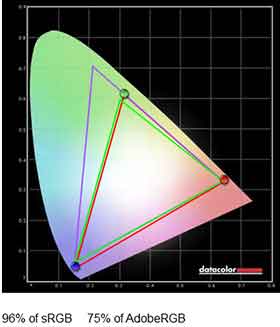
All Flip models, regardless of size have at least 1920 x 1080 displays. If you get the 15" model, there's a $300 2880 x 1620 option that should look very sweet. The Flip 15 with NVIDIA GT735M dedicated graphics, pen included and the higher display resolution gets pricey though, and Sony's preconfigured model sells for $1,799. That configuration does include a Core i7-4500U 1.8GHz dual core CPU, 16 gigs of RAM and a 5400 RPM terabyte HDD with 16 gig solid state boot drive, so it's a very well appointed machine. There's a 15 Flip for $1,249 stocked at Best Buy that has the Core i7, dedicated graphics, 8 gigs of RAM and a 1920 x 1080 display.
N-Trig Active Digitizer and Pen
All Flip models come with an active digitizer made by N-Trig. Sony's used N-Trig on their Duo models and the Flip works the same. One point of confusion: the pen isn't included with most SKUs, you'll have to pay $40 to get one from Sony (it's the same pen as used on the Vaio Duo 13, and it uses N-Trig DuoSense 2 technology). Generally if a tablet has an active digitizer the pen is included in the box, and I'm sure this will confuse some folks, or they might not even realize they can use a digital pen.
As ever, with N-Trig you get accurate tracking and 256 levels of pressure sensitivity. Though the pressure sensitivity doesn't compare well with Wacom's 1024 levels, this is something only artists would notice. Even then, 256 levels are enough to do advanced artwork even if I personally do prefer more levels for nuanced art work. N-Trig's pen tip tracking is better than Wacom's, especially near the edges of the screen where Wacom equipped convertibles and tablets tend to be off. You have to hold the pen closer to the display compared to Wacom, and that may be off-putting those accustomed to Wacom pen behavior since the digitizer must detect the pen before it will disable capacitive touch (also called palm rejection). N-Trig supports modern Windows Ink APIs so programs like MS Office 2013, ArtRage Studio 3.5 (bundled), Manga Studio 5 (change tablet settings to Tablet PC rather than WinTab) and Sketchbook Pro have pressure sensitivity. Adobe recently added Windows Ink support for Illustrator and Sony has released WinTab 32 big drivers for Photoshop, thus providing pressure sensitivity. Word is that Adobe will start supporting Windows Ink in 2014 for their Creative Cloud suite. When will Corel Painter and other programs that rely on WinTab follow suit? Who knows.
Performance and Horsepower
The Sony Vaio Flip 13 runs on 4th generation Intel Haswell ULV CPUs with Intel HD 4400 graphics. Unlike the Duo 13, there's no wildly expensive option to move to HD 5000 integrated graphics. Given the small performance difference, I'd spend my money on other things, so I won't ding the Flip 13. There is no dedicated graphics option for the 13 and 14 inch Flip models, likely due to cooling constraints. You can get the machine with 4 or 8 gigs of DDR3L 1600MHz RAM, which is soldered on board so you can't upgrade it yourself. The Flip 13 is available only with SSD drives, and you can get 128, 256 and 512 gig SATA SSDs. The SSD is socketed, so you could upgrade it yourself at a later date, but it uses the currently less common M.2 form factor that's hard to find aftermarket. The Flip 14 and 15 are available with conventional HDDs and SSD drives.
If you go with the Flip 15, you can order it with NVIDIA GeForce GT 735M with Optimus switchable dedicated graphics. That option nets you 2 gigs of VRAM and is a low-midrange solution that will boost 3D games and CAD performance though it won't have you playing Battlefield 4 at full HD and high settings.
Sony offers the Flip 13 with Core i3, i5 and i7 CPUs. We recommend avoiding the Core i3 since you only save $100 and lose Turbo Boost. Our unit is the one stocked at Best Buy and it has a 1.6 GHz Intel Core i5-4200U dual core CPU, 8 gigs of RAM and a 128 gig SSD ($1,199). Windows, Sony's generous software bundle (Acid Music Studio, SoundForge Audio Studio, DVD Architect and Movie Studio Platinum 12) and the recovery partition take up significant space, so our machine had 55 gigs left after installing Windows updates and MS Office 2013 Home Edition. After we upgraded to Windows 8.1 we gained almost 5 gigs of space, which has been par for the course when upgrading our Windows 8 machines to 8.1. We assume at some point Sony will start shipping the machine with 8.1 rather than 8.
This is a standard Ultrabook in terms of performance, and that means it's more than capable of MS Office work, email, full HD video playback and light gaming. You could use it for software development and some HD video editing, and Photoshop runs like a champ. It's not a gaming rig, so don't expect to play Battlefield 4 on medium or high settings. But less demanding games like Civ V at full HD with low-medium settings and WoW on low settings and 1366 x 768 resolution run fine.
Benchmarks
(1.6 GHz Intel Core i5-4200U, 8 gigs RAM and 128 gig SSD)
PCMark 7: 4434
3DMark 11: P753
wPrime: 22.6 sec.
Windows Experience Index:
Processor: 6.9
RAM: 7.5
Graphics (for desktop): 5.8
Gaming Graphics: 6.4
Primary Hard Disk: 8.0
PCMark 7 Benchmark Comparison Table
| Sony Vaio Flip 13 | 4434 |
| Lenovo Yoga 2 Pro | 4737 |
| Sony Vaio Duo 13 (Core i7) | 4800 |
| Sony Vaio Pro 13 (Core i5 Haswell) | 4549 |
| Sony Vaio Duo 11 (1.7GHz Core i5) | 4772 |
| Samusng ATIV Book 9 Plus | 5050 |
| Acer Aspire S7 (Core i7-4500U) | 5075 |
| Asus Transformer Book TX300 | 4495 |
| Acer Aspire R7 | 3981 |
| Asus Zenbook Prime UX31A Touch (Core i5) | 4670 |
| Dell XPS 12 (Core i5, Haswell) | 4889 |
| Asus Taichi 21 (Core i7) | 4952 |
| Microsoft Surface Pro 2 | 4905 |
CrystalDiskMark SSD Scores
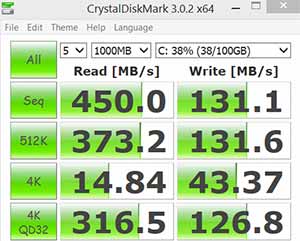
Battery Life and Fan Noise
Here are the two ugly items: battery life is OK but not stellar. The fan is on all the time. ALL THE TIME. From the moment you boot the machine and before the CPU has risen to a normal operating temperature, the fan is quite audible. Small machines have higher pitched fans, so it's noticeable. When the CPU is at 36C, which is well below the 100C max allowable and 45 to 50C where most Ultrabook fans come on, the fan is buzzing along. If you tax the machine a little bit and the CPU temp rises to 42C, the fan kicks in higher and louder. When editing several RAW files in Photoshop, our Flip 13 gets as loud as the Microsoft Surface Pro 2 playing Civ V at full HD resolution! In our offices, we've nicknamed our Flip 13 "Hoover", after the vacuum cleaner: it's that noticeable. Clearly Sony was overzealous with cooling and they could change the fan operation with a BIOS update. Will they do so? I don't know. Speaking of BIOS, there is no option for fan control. Your only option is selecting silent mode in Vaio Control settings, which unfortunately drops performance. For those who have used the Sony Vaio Pro 13 and found its fan too loud, the Flip 13 is even louder and more constant (the Pro 13 fan is generally busy only when plugged into power).
Back to battery life: the Vaio Flip 13 has a 3170 mAh Lithium Ion battery that's sealed inside. That's not a very big battery and in fact it's half the battery capacity of the Vaio Duo 13. I'm sure Sony went with a small battery to keep the machine very thin and light, and that's the tradeoff when you buy something even lighter than the 13" MacBook Air. Battery life isn't horrid at 6 hours; it's simply not excellent by Haswell standards. We average 6 hours of mixed use with automatic brightness disabled and display brightness set to 50% with WiFi and Bluetooth turned on. If you use a more power frugal plan setting (we used Balanced) or enable silent mode and drop the brightness a bit, you could get 7 hours. If that darned fan wasn't whirring away at all times, battery life could be even better.
Conclusion
The Sony Vaio Flip 13 is one of the most innovative and well designed Windows 8 convertibles on the market, if not the best. It's a normal Ultrabook with a gorgeous slim look and metal casing, and it's a tablet with a pen and it has presentation mode. There's no byzantine hinge, no keyboard keys tickling your legs and no display wobble. Better yet, the Vaio Flip is available in 3 sizes. It's superb stuff, and it reminds us of what Sony can do when they try. All the high end appointments are here: a IPS full HD display with rich colors, backlit keyboard, decent Intel dual band WiFi with WiDi, the latest gen Intel CPUs and SSD drives. We can live with just OK battery life--in truth 6 hours of actual use time is enough for us. But the fan? Unless Sony issues an update to remedy the constant noise, it's a deal breaker for us (and those around us who must put up with the noise).
Price: starting at $1,099 for Flip 13
Website: www.sony.com
Related Reviews:
Sony Vaio Flip 15 Review
Lenovo Yoga 2 Pro Review
Sony Vaio Duo 13 Review
Sony Vaio Pro 13 Review
Microsoft Surface Pro 2 Review
Dell XPS 12 Review
Lenovo ThinkPad Yoga Review
Samsung ATIV Book 9 Plus Review
Acer Aspire R7 Review
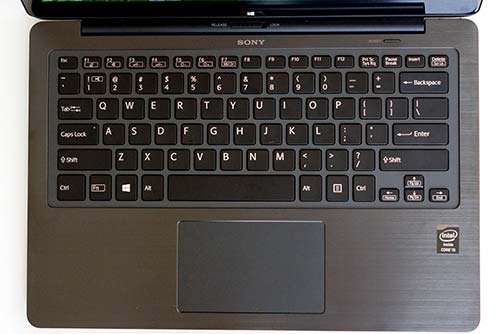
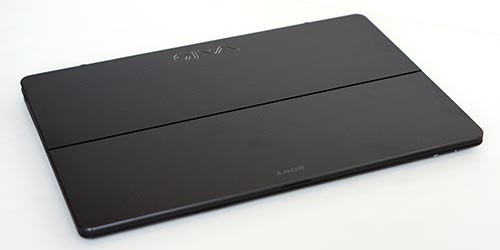
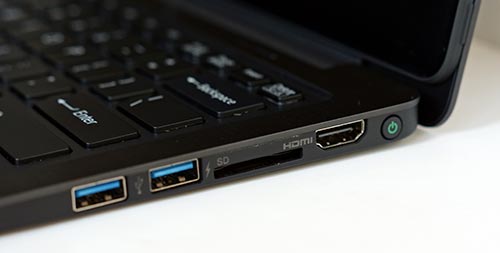
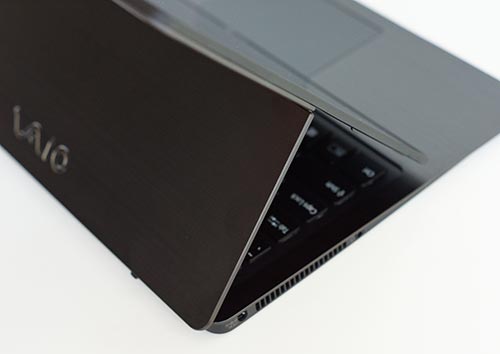
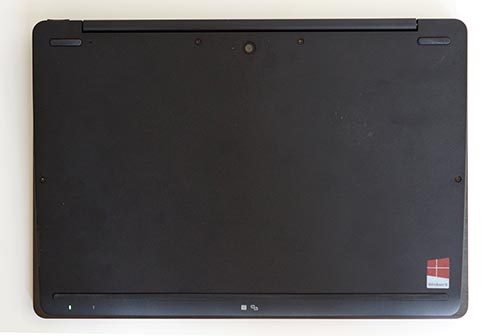
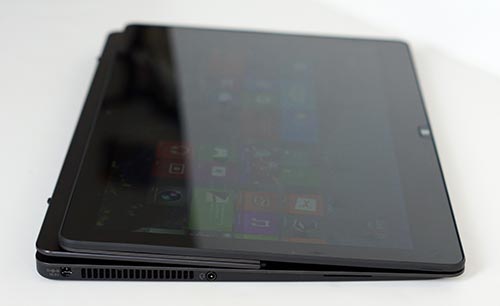
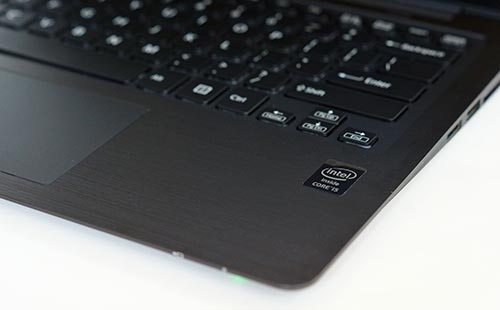
Specs:
Display: 13.3" IPS Triluminos display with capacitive touch and N-Trig active digitizer (pen sold separately with many SKUs). Resolution: full HD 1920 x 1080. Intel HD 4400 integrated graphics. HDMI port and Intel WiDi wireless display.
Battery: 3170 mAh Lithium Ion rechargeable, sealed inside. Claimed battery life: 6 hours.
Performance: Fourth generation Intel Haswell ULV CPUs, 1.7GHz Core i3-4005U (no Turbo Boost on Core i3), 1.6GHz Intel Core i5-4200U, 1.8GHz Core i7-4500U with HD 4400 graphics. 4 or 8 gigs of DDR3 LPDDR3-1600MHz RAM soldered to motherboard. 128, 256 and 512 gig SATA SSD options.
Size: : 12.81 (W) x 0.56 - 0.70"(H) x 8.80 (D) inches. Weight: 2.89 pounds.
Camera: 2MP front camera with Exmor R sensor. 8MP rear camera with Exmor RS sensor.
Audio: Built-in stereo speakers, mic and 3.5mm standard stereo headphone jack.
Networking: Integrated dual band Intel Wireless N-7260 WiFi 802.11b/g/n, Bluetooth 4.0 +HS and NFC.
Software: Windows 8 64 bit (Windows 8 Pro available). Kaspersky anti-virus trial, Sound Forge Studio 10, Movie Studio Platinum 12 (32 and 64 bit), Acid Music Studio 9, DVD Architect Studio 5, ArtRage Studio 3.5, Sony Reader for PC, Dragon Assistant (voice command and dictation), Vaio Movie Creator, PlayMemories Home and remote keyboard for Playstation.
Expansion and Ports: Two USB 3.0 ports (one charging), full size HDMI, 3.5mm combo audio and SDXC/MMC/Memory Stick Pro Duo card slot.
Source: https://www.mobiletechreview.com/notebooks/Sony-Vaio-Flip-13.htm
0 Response to "Upgrade to Windows 81 Causes Sony Vaio Fan to Continuously Run"
Post a Comment